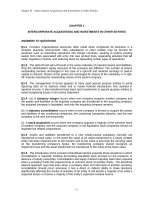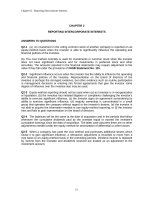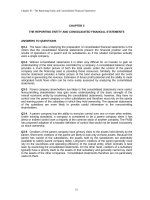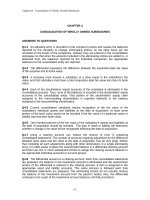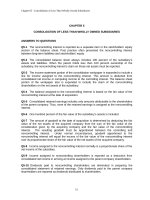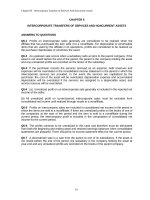Intermediate accounting 8th edition by spiceland sepe nelson thomas test bank
Bạn đang xem bản rút gọn của tài liệu. Xem và tải ngay bản đầy đủ của tài liệu tại đây (1.48 MB, 196 trang )
Intermediate Accounting 8th edition by J. David Spiceland, James
F. Sepe, Mark W. Nelson, Wayne B. Thomas Test Bank
Link full download test bank: />Link full download solution manual:
/>Chapter 02 Review of the Accounting Process Answer Key
True / False Questions
1.
Owners' equity can be expressed as assets minus liabilities.
TRUE
AACSB: Reflective
Thinking AICPA: BB Critical
Thinking Accessibility: Keyboard
Navigation
Blooms:
Remember Learning Objective: 02-01 Analyze routine economic events-transactions-and record their effects on a
company's financial
position using the accounting equation
format.
Level of Difficulty: 1
Easy Topic Area: The basic model-Accounting
equation
2.
Debits increase asset accounts and decrease liability accounts.
TRUE
AACSB: Reflective
Thinking AICPA: BB Critical
Thinking Accessibility: Keyboard
Navigation
Blooms:
Remember Learning Objective: 02-01 Analyze routine economic events-transactions-and record their effects on a
company's financial
position using the accounting equation
format.
Level of Difficulty: 1
2-1
Copyright © 2016 McGraw-Hill Education. All rights reserved. No reproduction or distribution without the prior written consent of
McGraw-Hill Education.
Easy Topic Area: The basic model-Account
relationships
3.
Balance sheet accounts are referred to as temporary accounts because their balances are always
changing.
FALSE
AACSB: Reflective
Thinking AICPA: BB Critical
Thinking Accessibility: Keyboard
Navigation
Blooms: Remember
2-2
Copyright © 2016 McGraw-Hill Education. All rights reserved. No reproduction or distribution without the prior written consent of
McGraw-Hill Education.
Learning Objective: 02-01 Analyze routine economic events-transactions-and record their effects on a company's
financial
position using the accounting equation
format.
Level of Difficulty: 1
Easy Topic Area: The basic model-Account
relationships
4.
After an unadjusted trial balance is prepared, the next step in the accounting processing cycle is the
preparation of financial statements.
FALSE
AACSB: Reflective
Thinking AICPA: BB Critical
Thinking Accessibility: Keyboard
Navigation
Blooms:
Remember Learning Objective: 02-01 Analyze routine economic events-transactions-and record their effects on a
company's financial
position using the accounting equation
format.
Level of Difficulty: 1
Easy Topic Area: Accounting
processing cycle
5.
Adjusting journal entries are recorded at the end of any period when financial statements are prepared.
TRUE
AACSB: Reflective
Thinking AICPA: BB Critical
Thinking Accessibility: Keyboard
Navigation
Blooms:
Remember Learning Objective: 02-04 Identify and describe the different types of
adjusting journal entries.
Level of Difficulty: 1
Easy Topic Area: Adjusting
entries
6.
Accruals occur when the cash flow precedes either revenue or expense recognition.
FALSE
2-100
Copyright © 2016 McGraw-Hill Education. All rights reserved. No reproduction or distribution without the prior written consent of
McGraw-Hill Education.
AACSB: Reflective
Thinking AICPA: BB Critical
Thinking Accessibility: Keyboard
Navigation
Blooms:
Remember Learning Objective: 02-04 Identify and describe the different types of
adjusting journal entries.
Level of Difficulty: 1
Easy Topic Area: Adjusting entriesIdentify types
2-101
Copyright © 2016 McGraw-Hill Education. All rights reserved. No reproduction or distribution without the prior written consent of
McGraw-Hill Education.
7.
The adjusted trial balance contains only permanent accounts.
FALSE
AACSB: Reflective
Thinking AICPA: BB Critical
Thinking Accessibility: Keyboard
Navigation
Blooms:
Remember Learning Objective: 02-05 Record adjusting journal entries in general journal format; post entries; and
prepare an adjusted trial
balance
Level of Difficulty: 1
Easy
Topic Area: Prepare an adjusted trial balance
8.
The income statement summarizes the operating activity of a firm at a particular point in time.
FALSE
AACSB: Reflective
Thinking AICPA: FN
Measurement Accessibility:
Keyboard Navigation
Blooms:
Remember Learning Objective: 02-06 Describe the four basic
financial statements.
Level of Difficulty: 1
Easy Topic Area: Preparing the financial
statements
9.
The balance sheet can be considered a change or flow statement.
FALSE
AACSB: Reflective
Thinking AICPA: FN
Measurement Accessibility:
Keyboard Navigation
Blooms:
Remember Learning Objective: 02-06 Describe the four basic
financial statements.
2-102
Copyright © 2016 McGraw-Hill Education. All rights reserved. No reproduction or distribution without the prior written consent of
McGraw-Hill Education.
Level of Difficulty: 1
Easy Topic Area: Preparing the financial
statements
2-103
Copyright © 2016 McGraw-Hill Education. All rights reserved. No reproduction or distribution without the prior written consent of
McGraw-Hill Education.
10.
The statement of cash flows summarizes transactions that caused cash to change during a reporting
period.
TRUE
AACSB: Reflective
Thinking AICPA: FN
Measurement Accessibility:
Keyboard Navigation
Blooms:
Remember Learning Objective: 02-06 Describe the four basic
financial statements.
Level of Difficulty: 1
Easy Topic Area: Preparing the financial
statements
11.
The statement of shareholders' equity discloses the changes in the temporary shareholders' equity
accounts.
FALSE
AACSB: Reflective
Thinking AICPA: FN
Measurement Accessibility:
Keyboard Navigation
Blooms:
Remember Learning Objective: 02-06 Describe the four basic
financial statements.
Level of Difficulty: 2
Medium Topic Area: Preparing the financial
statements
12.
The post-closing trial balance contains only permanent accounts.
TRUE
AACSB: Reflective
Thinking AICPA: BB Critical
Thinking Accessibility: Keyboard
Navigation
Blooms:
Remember Learning Objective: 02-07 Explain the
closing process.
2-104
Copyright © 2016 McGraw-Hill Education. All rights reserved. No reproduction or distribution without the prior written consent of
McGraw-Hill Education.
Level of Difficulty: 1
Easy Topic Area: Closing
process
2-105
Copyright © 2016 McGraw-Hill Education. All rights reserved. No reproduction or distribution without the prior written consent of
McGraw-Hill Education.
13.
The closing process brings all temporary accounts to a zero balance and updates the balance in the
retained earnings account.
TRUE
AACSB: Reflective
Thinking AICPA: BB Critical
Thinking Accessibility: Keyboard
Navigation
Blooms:
Remember Learning Objective: 02-07 Explain the
closing process
Level of Difficulty: 1
Easy Topic Area: Closing
process
14.
A reversing entry at the beginning of a period for salaries would include a debit to salaries expense.
FALSE
AACSB: Reflective
Thinking AICPA: BB Critical
Thinking Accessibility: Keyboard
Navigation
Blooms:
Remember Learning Objective: 02-Appendix 2B
Reversing Entries.
Level of Difficulty: 2
Medium Topic Area:
Reversing entries
15.
The sale of merchandise on account would be recorded in a sales journal.
TRUE
AACSB: Reflective
Thinking AICPA: BB Critical
Thinking Accessibility: Keyboard
Navigation
Blooms:
Remember Learning Objective: 02-Appendix 2C Subsidiary Ledgers and
Special Journals.
Level of Difficulty: 1
2-106
Copyright © 2016 McGraw-Hill Education. All rights reserved. No reproduction or distribution without the prior written consent of
McGraw-Hill Education.
Easy Topic Area: Subsidiary ledgers and special
journals
2-107
Copyright © 2016 McGraw-Hill Education. All rights reserved. No reproduction or distribution without the prior written consent of
McGraw-Hill Education.
16.
The payment of cash to a supplier would be recorded in a purchases journal.
FALSE
AACSB: Reflective
Thinking AICPA: BB Critical
Thinking Accessibility: Keyboard
Navigation
Blooms:
Remember Learning Objective: 02-Appendix 2C Subsidiary Ledgers and
Special Journals.
Level of Difficulty: 1
Easy Topic Area: Subsidiary ledgers and special
journals
Multiple Choice Questions
17.
The accounting equation can be stated as:
A. A + L - OE = 0.
B. A - L + OE = 0.
C. -A + L - OE = 0.
D. A - L - OE = 0.
AACSB: Reflective
Thinking AICPA: BB Critical
Thinking Accessibility: Keyboard
Navigation
Blooms:
Remember Learning Objective: 02-01 Analyze routine economic events-transactions-and record their effects on a
company's financial
position using the accounting equation
format.
Level of Difficulty: 2
Medium Topic Area: The basic modelAccounting equation
2-108
Copyright © 2016 McGraw-Hill Education. All rights reserved. No reproduction or distribution without the prior written consent of
McGraw-Hill Education.
18.
Examples of external transactions include all of the following except:
A. Paying employee salaries.
B. Purchasing equipment.
C. Depreciating equipment.
D. Collecting a receivable.
AACSB: Reflective
Thinking AICPA: BB Critical
Thinking Accessibility: Keyboard
Navigation
Blooms:
Understand Learning Objective: 02-01 Analyze routine economic events-transactions-and record their effects on a
company's financial
position using the accounting equation
format.
Level of Difficulty: 2
Medium Topic Area: The
basic mode
19.
Examples of internal transactions include all of the following except:
A. Writing off an uncollectible account.
B. Recording the expiration of prepaid insurance.
C. Recording unpaid salaries.
D. Paying salaries to company employees.
AACSB: Reflective
Thinking AICPA: BB Critical
Thinking Accessibility: Keyboard
Navigation
Blooms:
Understand Learning Objective: 02-01 Analyze routine economic events-transactions-and record their effects on a
company's financial
position using the accounting equation
format.
Level of Difficulty: 2
Medium Topic Area: The
basic mode
2-109
Copyright © 2016 McGraw-Hill Education. All rights reserved. No reproduction or distribution without the prior written consent of
McGraw-Hill Education.
20.
XYZ Corporation receives $100,000 from investors for issuing them shares of its stock. XYZ's journal
entry to record this transaction would include a:
A. Debit to investments.
B. Credit to retained earnings.
C. Credit to capital stock.
D. Credit to revenue.
AACSB: Analytical
Thinking AICPA: FN
Measurement Accessibility:
Keyboard Navigation
Blooms:
Analyze Learning Objective: 02-02 Record transactions using the general
journal format.
Level of Difficulty: 2
Medium Topic Area: Record transactions in the
general journal
21.
Incurring an expense for advertising on account would be recorded by:
A. Debiting liabilities.
B. Crediting assets.
C. Debiting an expense.
D. Debiting assets.
AACSB: Analytical
Thinking AICPA: FN
Measurement Accessibility:
Keyboard Navigation
Blooms:
Analyze Learning Objective: 02-02 Record transactions using the general
journal format.
Level of Difficulty: 2
Medium Topic Area: Record transactions in the
general journal
2-110
Copyright © 2016 McGraw-Hill Education. All rights reserved. No reproduction or distribution without the prior written consent of
McGraw-Hill Education.
22.
A sale on account would be recorded by:
A. Debiting revenue.
B. Crediting assets.
C. Crediting liabilities.
D. Debiting assets.
AACSB: Analytical
Thinking AICPA: FN
Measurement Accessibility:
Keyboard Navigation
Blooms:
Analyze Learning Objective: 02-02 Record transactions using the general
journal format.
Level of Difficulty: 2
Medium Topic Area: Record transactions in the
general journal
23.
Mary Parker Co. invested $15,000 in ABC Corporation and received capital stock in exchange. Mary
Parker Co.'s journal entry to record this transaction would include a:
A. Debit to investments.
B. Credit to retained earnings.
C. Credit to capital stock.
D. Debit to expense.
AACSB: Analytical
Thinking AICPA: FN
Measuremen
Accessibility: Keyboard Navigation
Blooms:
Analyze Learning Objective: 02-02 Record transactions using the general
journal format.
Level of Difficulty: 2
Medium Topic Area: Record transactions in the
general journal
2-111
Copyright © 2016 McGraw-Hill Education. All rights reserved. No reproduction or distribution without the prior written consent of
McGraw-Hill Education.
24.
Hughes Aircraft sold a four-passenger airplane for $380,000, receiving a $50,000 down payment
and a 12% note for the balance. The journal entry to record this sale would include a:
A. Credit to cash.
B. Debit to cash discount.
C. Debit to note receivable.
D. Credit to note receivable.
AACSB: Analytical
Thinking AICPA: FN
Measurement Accessibility:
Keyboard Navigation
Blooms:
Analyze Learning Objective: 02-02 Record transactions using the general
journal format.
Level of Difficulty: 3
Hard Topic Area: Record transactions in the
general journal
2-112
Copyright © 2016 McGraw-Hill Education. All rights reserved. No reproduction or distribution without the prior written consent of
McGraw-Hill Education.
25.
Somerset Leasing received $12,000 for 24 months' rent in advance. How should Somerset record
this transaction?
A. Prepaid 12,000
rent
Rent
expense
12,000
B. Cash
12,000
Deferred
revenue
C. Interest
12,000
expense
Interest
payable
D. Salaries
expense
Salaries
payable
12,000
12,000
12,000
12,000
AACSB: Analytical
Thinking AICPA: FN
Measurement
Blooms:
Analyze Learning Objective: 02-02 Record transactions using the general
journal format.
Level of Difficulty: 2
Medium Topic Area: Record transactions in the
general journal
2-113
Copyright © 2016 McGraw-Hill Education. All rights reserved. No reproduction or distribution without the prior written consent of
McGraw-Hill Education.
26.
Davis Hardware Company uses a perpetual inventory system. How should Davis record the sale of
merchandise, costing $620, and sold on account for $960?
A. Inventory
620
Accounts receivable
Sales
620
960
Revenue from sales
B. Accounts
960
960
receivable
Sales revenue
960
Cost of goods sold 620
Inventory
C. Inventory
Gain on sale
620
620
340
Sales
revenue
960
D. Accounts receivable 960
Sales revenues
620
Gain on sale
340
2-110
Copyright © 2016 McGraw-Hill Education. All rights reserved. No reproduction or distribution without the prior written consent of
McGraw-Hill Education.
AACSB: Analytical
Thinking AICPA: FN
Measurement
Blooms:
Apply Learning Objective: 02-02 Record transactions using the general
journal format.
Level of Difficulty: 3
Hard Topic Area: Record transactions in the
general journal
2-111
Copyright © 2016 McGraw-Hill Education. All rights reserved. No reproduction or distribution without the prior written consent of
McGraw-Hill Education.
27.
Ace Bonding Company purchased merchandise inventory on account. The inventory costs
$2,000 and is expected to sell for $3,000. How should Ace record the purchase?
A. Inventory
2,000
Accounts
payable
B. Cost of
2,000
2,000
goods
sold
Deferred 1,000
revenue
Sales
3,000
in
advance
C. Cost of
2,000
goods sold
Inventory
payable
2,000
D. Cost of 2,000
goods
sold
Profit
Sales
payable
1,000
3,000
AACSB: Analytical Thinking
2-112
Copyright © 2016 McGraw-Hill Education. All rights reserved. No reproduction or distribution without the prior written consent of
McGraw-Hill Education.
AICPA: FN Measurement
Blooms:
Apply Learning Objective: 02-02 Record transactions using the general
journal format
Level of Difficulty: 3
Hard Topic Area: Record transactions in the
general journal
28.
Which of the following accounts has a normal debit balance?
A. Accounts payable.
B. Accrued taxes.
C. Accumulated depreciation.
D. Advertising expense.
AACSB: Reflective
Thinking AICPA: BB Critical
Thinking Accessibility: Keyboard
Navigation
Blooms:
Remember Learning Objective: 02-01 Analyze routine economic events-transactions-and record their effects on a
company's financial
position using the accounting equation
format. Learning Objective: 02-05 Record adjusting journal entries in general journal format; post entries; and prepare
an adjusted trial
balance
Level of Difficulty: 1
Easy
Topic Area: Prepare an adjusted trial
balance Topic Area: The basic model-Account
relationships
29.
An example of a contra account is:
A. Depreciation expense.
B. Accounts receivable.
C. Sales revenue.
D. Accumulated depreciation.
AACSB: Reflective
Thinking AICPA: BB Critical
2-113
Copyright © 2016 McGraw-Hill Education. All rights reserved. No reproduction or distribution without the prior written consent of
McGraw-Hill Education.
Thinking Accessibility: Keyboard
Navigation
Blooms:
Remember Learning Objective: 02-04 Identify and describe the different types of
adjusting journal entries.
Level of Difficulty: 1
Easy Topic Area: Adjusting entriesIdentify types
2-114
Copyright © 2016 McGraw-Hill Education. All rights reserved. No reproduction or distribution without the prior written consent of
McGraw-Hill Education.
30.
Making insurance payments in advance is an example of:
A. An accrued receivable transaction.
B. An accrued liability transaction.
C. A deferred revenue transaction.
D. A prepaid expense transaction.
AACSB: Reflective
Thinking AICPA: BB Critical
Thinking Accessibility: Keyboard
Navigation
Blooms:
Understand Learning Objective: 02-04 Identify and describe the different types of
adjusting journal entries.
Level of Difficulty: 1
Easy Topic Area: Adjusting entriesIdentify types
31.
Recording revenue that is earned, but not yet collected, is an example of:
A. A prepaid expense transaction.
B. A deferred revenue transaction.
C. An accrued liability transaction.
D. An accrued receivable transaction.
AACSB: Reflective
Thinking AICPA: BB Critical
Thinking Accessibility: Keyboard
Navigation
Blooms:
Understand Learning Objective: 02-04 Identify and describe the different types of
adjusting journal entries.
Level of Difficulty: 1
Easy Topic Area: Adjusting entriesIdentify types
2-115
Copyright © 2016 McGraw-Hill Education. All rights reserved. No reproduction or distribution without the prior written consent of
McGraw-Hill Education.
32.
When a magazine company collects cash for selling a subscription, it is an example of:
A. An accrued liability transaction.
B. An accrued receivable transaction.
C. A prepaid expense transaction.
D. A deferred revenue transaction.
AACSB: Reflective
Thinking AICPA: BB Critical
Thinking Accessibility: Keyboard
Navigation
Blooms:
Understand Learning Objective: 02-04 Identify and describe the different types of
adjusting journal entries.
Level of Difficulty: 1
Easy Topic Area: Record transactions in the
general journal
33.
On December 31, 2015, Coolwear, Inc. had a balance in its prepaid insurance account of
$48,400. During 2016, $86,000 was paid for insurance. At the end of 2016, after adjusting entries were
recorded, the balance in the prepaid insurance account was 42,000. Insurance expense for 2016 would be:
A. $6,400.
B. $134,400.
C. $86,000.
D. $92,400.
Insurance expense = $48,400 + 86,000 - 42,000 = $92,400
AACSB: Analytical
Thinking AICPA: FN
Measurement Accessibility:
Keyboard Navigation
Blooms:
Analyze Learning Objective: 02-05 Record adjusting journal entries in general journal format; post entries; and prepare
an adjusted trial
balance
Learning Objective: 02-08 Convert from cash basis net income to accrual basis net
income.
Level of Difficulty: 2
Medium Topic Area: Adjusting entries2-116
Copyright © 2016 McGraw-Hill Education. All rights reserved. No reproduction or distribution without the prior written consent of
McGraw-Hill Education.
Record and post
Topic Area: Conversion from cash basis to accrual basis
2-117
Copyright © 2016 McGraw-Hill Education. All rights reserved. No reproduction or distribution without the prior written consent of
McGraw-Hill Education.
34.
Adjusting entries are primarily needed for:
A. Cash basis accounting.
B. Accrual accounting.
C. Current value accounting.
D. Manual accounting systems.
AACSB: Reflective
Thinking AICPA: BB Critical
Thinking Accessibility: Keyboard
Navigation
Blooms:
Remember Learning Objective: 02-04 Identify and describe the different types of
adjusting journal entries.
Level of Difficulty: 1
Easy Topic Area: Adjusting
entries
35.
Prepayments occur when:
A. Cash flow precedes expense recognition.
B. Sales are delayed pending credit approval.
C. Customers are unable to pay the full amount due when goods are delivered.
D. Manufactured goods await quality control inspections.
AACSB: Reflective
Thinking AICPA: BB Critical
Thinking Accessibility: Keyboard
Navigation
Blooms:
Remember Learning Objective: 02-04 Identify and describe the different types of
adjusting journal entries.
Level of Difficulty: 2
Medium Topic Area: Adjusting entriesIdentify types
2-118
Copyright © 2016 McGraw-Hill Education. All rights reserved. No reproduction or distribution without the prior written consent of
McGraw-Hill Education.


